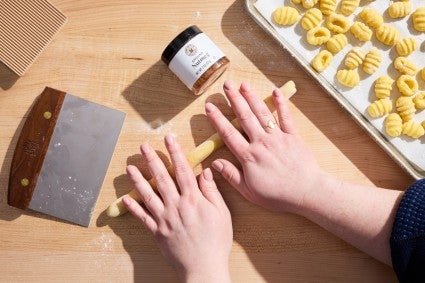


Gnocchi just might be the easiest pasta to make at home.
Rather than cooking up like regular pasta — al dente, with a slight “bite” — gnocchi are soft as a pillow. Their slightly indented undersides catch and hold your favorite sauce — marinara, pesto, or a simple mix of olive oil, parsley, and garlic. And, serendipitously, gnocchi are extremely easy to make. Just follow the steps below, and you'll soon be enjoying tasty homemade gnocchi regularly.

First, choose your recipe. We recommend this classic Potato Gnocchi, but you can also make Sweet Potato Gnocchi, which is similar but uses sweet potatoes in place of regular potatoes for a flavorful, orange-hued dough.
For classic Potato Gnocchi, you need about 1 1/4 cups (266g) mashed or riced russet potatoes. (If you have a potato ricer, now is the time to use it! Ricing produces exceptionally light gnocchi. Mashing is also an option, but use a light hand and know that you may need to cook the gnocchi for a few minutes longer.)
Baker's tip: We've also made gnocchi using instant mashed potatoes in place of fresh mashed potatoes.
Put the potatoes in a bowl, and add 1/4 teaspoon baking powder, 1 cup (106g) King Arthur Italian-Style Flour, 1/4 cup (28g) freshly grated Parmesan cheese, 2 egg yolks, 1/2 teaspoon salt, and a pinch of nutmeg. Stir to combine, mixing just until everything comes together into a cohesive ball.
Place the dough on a floured work surface, cover with the inverted bowl, and let it rest for 30 minutes.
Take about a third of the dough and roll it into a rope about 1/2" thick, or the width of your thumb.

Use a pair of scissors, a bench knife, or a knife to cut the ropes into 1/2” to 3/4” pieces.

Place the pieces on a piece of parchment or waxed paper lightly coated with flour.
Next, the gnocchi board. This wooden board is going to give your gnocchi their distinctive shape. Place the bottom of the board on a firm surface, tilt it at about a 45° angle, and place one piece of dough on the board. Use your thumb or the accompanying wand to roll it along the board away from you, for about 3/4". It'll curl up over your thumb, forming a little pocket.

Toss the finished gnocchi onto the prepared parchment. Repeat with all the pieces of dough, placing them back onto the flour-dusted parchment, and giving the pan an occasional shake to roll the shaped gnocchi around in the flour.
Yes, though not quite as successfully. You can use a fork to shape instead of a gnocchi board, but the fork can be slippery to use, and the gnocchi tend to wobble around and slide off, rather than forming a nice, neat pocket.
Or consider making gnocchi that don't get shaped that way, like ricotta gnocchi, which are just cut into small nuggets and skip the shaping.
Once all the gnocchi are shaped, cook them right away, or dust with flour, cover with a kitchen towel, and let rest at room temperature for up to several hours. You can also wrap them tightly (in a single layer), and store in the fridge for a day or freeze for up to several months.
To cook the gnocchi, bring a large, wide pot of water to a boil; a deep sauté pan works well. Add 1/2 teaspoon salt to the water.
Drop as many gnocchi into the boiling water as will fit without crowding. Once gnocchi float to the surface, cook for 4 to 6 minutes. Remove the gnocchi from the water with a strainer or slotted spoon; or turn out into a colander.
If you're not going to serve immediately, toss with a bit of olive oil, cool, cover, and refrigerate for up to 24 hours. To reheat, dip in boiling water for about 20 seconds.

Just before you cook the gnocchi, prepare your sauce. Either store-bought or homemade works; whichever you prefer.
Cover photo by Patrick Marinello; food styling by Yekaterina Boytsova.



